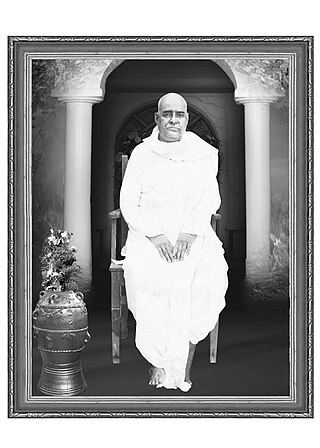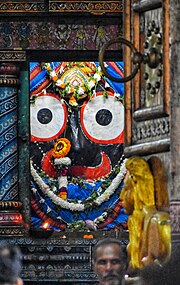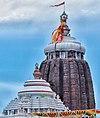
Odissi music is a genre of classical music in India, originated from the eastern state of Odisha. The traditional ritual music for the service of Lord Jagannatha, Odissi music has a history spanning over two thousand years, authentic sangita-shastras or treatises, unique Ragas & Talas and a distinctive style of rendition.

Durga Charan Mohanty (Odia:ଦୁର୍ଗାଚରଣ ମହାନ୍ତି, was an Odia Indian spiritual writer born in 1912 at Biratunga, a village under block Gop, near Konark, Odisha. The Odia Sahitya Akademi has been awarded to him in 1956–58 due to his active involvement in development of Odia language and literature Being a disciple of Swami Nigamananda, he wrote many books and translated Nigamananda's own-written Bengali books to Odia language. He was ପରିଚାଳକ of ନୀଳାଚଳ ସାରସ୍ୱତ ସଂଘ.

KabisurjyaBaladeba Ratha was an Indian poet who wrote in the Odia language, and a composer and musician of Odissi music, most known as poet-composer of the Champu. Kabisurjya has composed hundreds of songs in the tradition of Odissi music, employing unique traditional ragas & talas. His magnum opus Kisorachandrananda Champu is a cornerstone of the Odissi music repertoire & Kabisurjya is widely renowned for his masterful compositions. He wrote in both Sanskrit and Odia. His works are known for their devotional quotient and he is the credited founder of the Dhumpa Sangita tradition.

The Gitaprakasa is a 16th-century musical treatise belonging to the tradition of Odissi music, written by the musicologist Krusnadasa Badajena Mahapatra. Mahapatra was a court musician of Gajapati Mukundadeba. It is the second earliest music treatise discovered from Odisha. The Gita Prakasa is one of the cornerstones of the Odissi music tradition and is widely quoted by later authorities such as the Sangita Narayana and the Sangita Muktabali.

Gopalakrusna Pattanayaka was an Odia poet & composer of Odissi music. His Odissi songs in various traditional ragas and talas are widely sung across the state, as well as other allied traditional artforms of Odisha, such as pala. The 20th-century Odissi musician, vocalist & binākara Apanna Panigrahi, also from the poet's hometown, was well-known for his renditions of Gopalakrusna's lyrics. Some of the most iconic Odissi songs, such as Syamaku Juhara Tara Premaku Juhara Ma, Jala Ani Jai Kali Kalindasutaku, Sangini Re Rasarangini Re, Kadamba Bane Bansi Bajila Re, Uthilu Ede Begi Kahinkire, Ki Nadare Prana Sangini, Manasija Mana Mohana are creations of Gopalakrusna. Many of his songs are popular abhinaya items in Odissi dance.

PanditRamhari Das is a leading singer, composer, musicologist and Guru of Odissi music. Known for his renditions, compositions, lecture-demonstrations and writings, Das has served as a professor and led the Odissi vocal department in prominent musical institutions of Odisha, including the Utkal Sangeet Mahavidyalaya and the Utkal University of Culture. He is the founder of Ramhari Das Odissi Gurukula at Biragobindapur, Puri. For his contributions to Odissi music, Das received the Sangeet Natak Akademi award in 2008.

Shyamamani Devi is a Odissi classical music vocalist composer. A disciple of Gurus Singhari Shyamsundar Kar and Balakrushna Dash, she is known for her popular renditions of classical Odissi music, such as Odissi, Chhanda, Champu, etc. authored by medieval Odia musician-poets such as Upendra Bhanja, Kabisurjya Baladeba Ratha, Banamali Dasa, Gopalakrusna and others. She is also known for her renditions of light music such as traditional Odia folk music ,Odia film music and adhunika songs. In 2022, she was awarded the Padma Shri for he contributions to Odissi music.

Desaraja AdiguruSinghari Shyamasundar Kar was a renowned Odissi musician, Guru, singer, scholar and composer. Born to a sebayata (servitor) family of the Jagannatha Temple, he was groomed under veteran masters of the temple tradition and soon rose to be one of the towering Gurus of Odissi classical music in the 20th century. He was most known for his powerful voice and intricate style, his command over the Mardala as well as his contribution towards the academic institutionalization of Odissi music education. Most of the performers of Odissi music, Mardala and Odissi dance of his period admit to having come under the commanding influence and knowledge of Singhari. He died on 16 March 1975.

The Sangita Narayana is a 17th-century musical treatise belonging to the tradition of Odissi music, written by musician Kabiratna Purusottama Misra and attributed to Gajapati Sarbagya Jagannatha Narayana Deva of Paralakhemundi. It is one of the most important musical treatises discovered from Odisha and is one of the fundamental texts followed in Odissi music till date. The treatise was first published by the Odisha Sangeet Natak Akademi in 1966, followed by a critical edition published by the Indira Gandhi National Centre for the Arts in 2009. Manuscripts of the work are found across India, indicating its national circulation. In 1987, Jonathan Katz in his D. Phil. thesis extensively analysed the musicological portions of the Sangitanarayana.
Dhanasri is a rāga belonging to the tradition of Odissi music. Falling under the meḷa of the same name, the raga uses komala gandhara and komala nisada swaras and is traditionally associated with the karuṇa rasa. The raga is mentioned in treatises such as the Gita Prakasa and Sangita Narayana.
Ramakeri is a rāga belonging to the tradition of Odissi music. Falling under the meḷa Barādi, the raga uses komala rusabha, komala dhaibata and tibra madhyama swaras and is traditionally associated with the karuṇa rasa. The raga is mentioned in treatises such as the Gita Prakasa and Sangita Narayana. This raga has been used by the 12th-century Odia composer Jayadeva in his Gita Govinda.
Baradi is a rāga belonging to the tradition of Odissi music. Falling under the meḷa Barādi, the raga uses komala rusabha, komala dhaibata and tibra madhyama swaras and is traditionally associated with the karuṇa rasa. The raga is mentioned in treatises such as the Gita Prakasa and Sangita Narayana. This raga has been used by the 12th-century Odia composer Jayadeva in his Gita Govinda along with its angaraga Desa Barādi.
Sokabaradi is a rāga belonging to the tradition of Odissi music. Falling under the meḷa of the same name, the raga uses komala rusabha, komala dhaibata, komala nisada and tibra madhyama swaras and is traditionally associated with the karuṇa rasa. The raga is mentioned in treatises such as the Gita Prakasa and Sangita Narayana.
Mangala Gujjari is a rāga belonging to the tradition of Odissi music. Falling under the meḷa Karnāta, the raga uses komala rusabha, komala gandhara, komala dhaibata and komala nisada swaras along with their suddha counterparts and is traditionally associated with the karuṇa rasa. The raga is mentioned in treatises such as the Gita Prakasa and Sangita Narayana. This raga is traditionally believed to have been created by Jayadeva in his Gita Govinda.
Abhiri is a rāga belonging to the tradition of Odissi music. Falling under the meḷa Karnāta, the raga uses komala gandhara, komala dhaibata and komala nisada swaras and is traditionally associated with the karuṇa rasa. The raga is mentioned in treatises such as the Gita Prakasa and Sangita Narayana.
Kedaragouda is a rāga belonging to the tradition of Odissi music. Falling under the meḷa Sri, the raga uses both nisada swaras and is traditionally associated with the srungāra rasa. This raga is considered a conjunct of the rāgas Kedāra and Goudā. The raga is mentioned in treatises such as the Gita Prakasa and Sangita Narayana. The most famous song in this raga is from the Kisorachandrananda Champu, a composition of Kabisurjya Baladeba Ratha.
Debagandhari is a rāga belonging to the tradition of Odissi music. Falling under the meḷa of the same name, the raga uses komala dhaibata and is traditionally associated with the karuṇa rasa.
Debakiri is a rāga belonging to the tradition of Odissi music. Falling under the meḷa Dhanasri, the raga uses komala gandhara and komala nisada swaras and is traditionally associated with the karuṇa and bhakti rasas. The raga is mentioned in treatises such as the Gita Prakasa and Sangita Narayana.
Sri is a rāga belonging to the tradition of Odissi music. Falling under the meḷa of the same name, the raga uses komala nisada swara and is traditionally associated with the melancholic karuna rasa. The raga is mentioned in treatises such as the Gita Prakasa and Sangita Narayana. Among its angaragas, Dhanasri, Bangalasri, Karunasri, Malasri, Madhusri, Dakhinasri are well-known.








